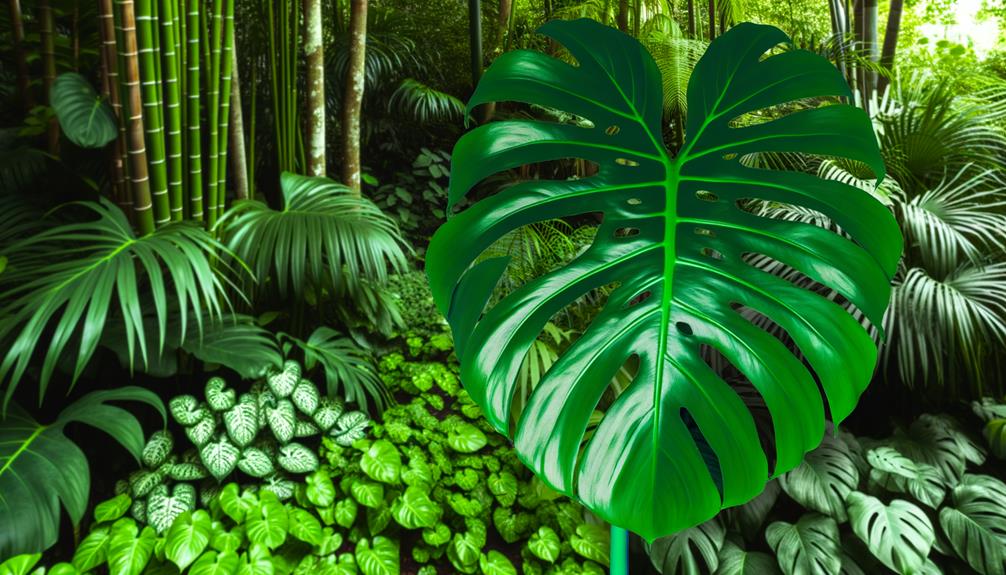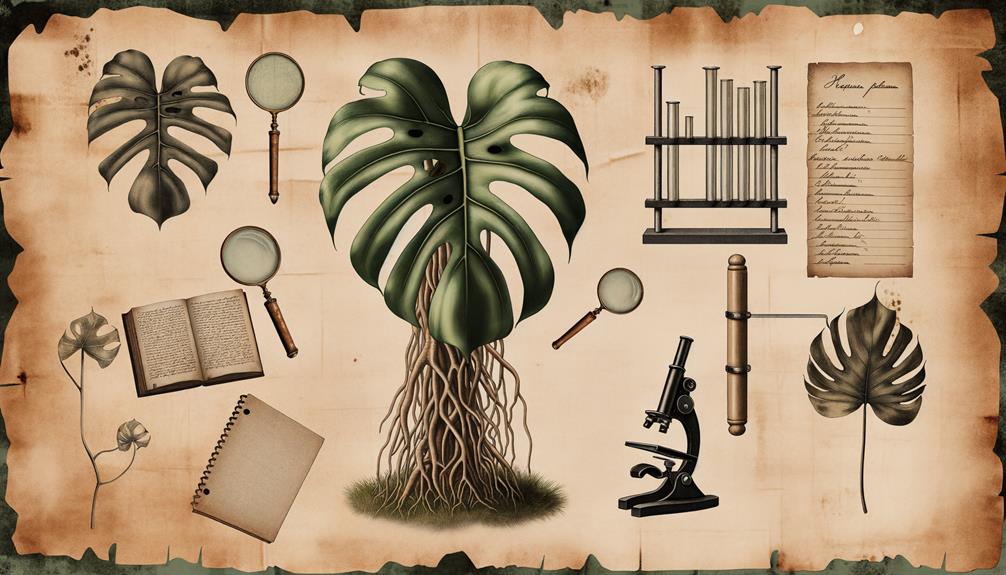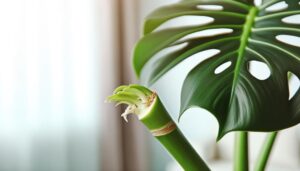Common Name for Monstera Deliciosa: A Comprehensive Guide
Monstera deliciosa, a member of the Araceae family, is commonly known as the Swiss cheese plant. This name derives from its distinctive fenestrated leaves, which resemble perforated Swiss cheese.
Native to the tropical rainforests of Central America, Monstera deliciosa features heart-shaped, leathery leaves that can reach up to 90 cm in length. The plant’s epiphytic nature, characterized by aerial roots, facilitates nutrient absorption and climbing.
The Swiss cheese plant not only holds aesthetic value in modern home decoration but also offers unique botanical characteristics. Continue exploring to uncover more about its historical context and best care practices.

Key Takeaways
- Monstera Deliciosa is commonly known as the Swiss cheese plant.
- Another common name for Monstera Deliciosa is Mexican breadfruit.
- The plant is also referred to as split-leaf philodendron.
- In some regions, it is called ceriman.
- It is often labeled as the fruit salad plant due to its edible fruit.
Common Names and Characteristics of Monstera Deliciosa
| Common Name | Region or Usage | Key Characteristics | Popular Uses |
|---|---|---|---|
| Swiss Cheese Plant | North America, Europe | Named for its large, fenestrated (holey) leaves resembling Swiss cheese. | Used as an ornamental plant in homes and offices due to its unique leaf pattern. |
| Split-Leaf Philodendron | Popular in horticulture and gardening | Often mistaken for philodendrons due to its similar leaf shape, though it’s a distinct species. | Common in gardens and as an indoor plant, appreciated for its air-purifying qualities. |
| Mexican Breadfruit | Mexico, Central America | Refers to the plant’s fruit, which is edible when fully ripe and resembles a spiky breadfruit. | Occasionally harvested for its fruit in tropical regions. |
| Ceriman | Native to the Caribbean | Another term related to its edible fruit, commonly used in tropical countries. | Cultivated for both ornamental and fruit purposes in tropical areas. |
| Fruit Salad Plant | Australia, New Zealand | Refers to the taste of its fruit, which is said to resemble a blend of pineapple and banana. | Grown for both decorative purposes and occasionally for its edible fruit. |
| Windowleaf | Commonly used in horticulture | Named for the natural window-like openings in its leaves, which aid in sunlight penetration. | Popular as a decorative houseplant due to its dramatic leaf structure. |
Origins of the Name

The name ‘Monstera deliciosa‘ stems from the Latin words ‘monstrum,’ signifying monster, and ‘deliciosa,’ referencing the plant’s edible fruit, showcasing both its large, uncommon leaves and its fruit’s distinct taste. This nomenclature encapsulates the plant’s remarkable characteristics, particularly its perforated and fenestrated leaves.
Taxonomically, Monstera deliciosa belongs to the Araceae family, under the Monstera genus. The species epithet ‘deliciosa’ hints at the fruit’s delightful flavor, which is a mix of pineapple and banana-like notes.
Indigenous to tropical rainforests of southern Mexico and Panama, the plant thrives in humid, warm environments. Its vigorous growth and aerial roots also indicate its epiphytic nature, enabling it to climb trees and absorb nutrients from the surrounding air and debris.
Monstera Deliciosa Is Also Known As What
Monstera deliciosa is also commonly known by several other names, including:
- Swiss Cheese Plant – due to the characteristic holes (fenestrations) in its leaves, which resemble Swiss cheese.
- Split-leaf Philodendron – although it’s not a true philodendron, it is sometimes mistakenly referred to as one because of its similar appearance.
- Mexican Breadfruit – because of the edible fruit it produces in its native tropical environments.
- Windowleaf – another name referencing the holes in its leaves.
These names often highlight the plant’s unique leaf structure and its tropical origin.
Meaning Behind ‘Swiss Cheese Plant’
In addition to its Latin nomenclature, Monstera deliciosa is colloquially known as the ‘Swiss Cheese Plant‘ due to the characteristic perforations and fenestrations in its leaves, reminiscent of the holes in Swiss cheese.
The distinctive morphology of the plant’s foliage, scientifically termed fenestration, serves functional purposes, such as enhancing light penetration and reducing wind resistance. This Monstera species belongs to the Araceae family, a group known for their unique leaf structures.
The fenestrated leaves are not only aesthetically pleasing but also evolutionarily advantageous, contributing to the plant’s adaptability in its native tropical habitats. The development of these natural perforations occurs as the leaves mature, a process influenced by both genetic factors and environmental conditions.
Historical Context

Tracing its origins to the rainforests of Central America, Monstera deliciosa has a rich history intertwined with indigenous cultures and botanical exploration. Belonging to the family Araceae, this species was first documented by European botanists during the 18th century.
Indigenous populations utilized the plant for its edible fruit, which is noted for its unique, sweet flavor. The scientific nomenclature, Monstera deliciosa, reflects both its imposing appearance and culinary value. The genus name ‘Monstera’ derives from the Latin word for ‘monstrous’ or ‘abnormal,’ referring to its large, fenestrated leaves. The species epithet ‘deliciosa’ highlights the plant’s delightful fruit.
During the colonial period, European explorers and botanists propagated the plant widely, contributing to its global distribution and popularity.
Physical Characteristics
Monstera deliciosa is a climber from the Araceae family. It exhibits distinctive morphological features that contribute to its popularity. The large, glossy leaves are characterized by their fenestrations and pinnate structure, which can reach up to 90 cm in length.
Additionally, the plant possesses unique aerial roots that allow it to anchor to surfaces and absorb moisture and nutrients from the air.
Leaf Shape and Size
The leaves of Monstera deliciosa are characterized by their large size and distinctive fenestrations, which are the natural splits and holes that develop as the plant matures. These leaves can reach up to 90 centimeters in length and are typically heart-shaped, exhibiting a glossy, deep green color.
The fenestrations, or perforations, increase in number and size as the plant ages, providing an adaptive advantage by allowing light to penetrate through to lower leaves. Taxonomically classified within the Araceae family, Monstera deliciosa’s leaf morphology is a significant identifier.
The leaf surface is leathery and robust, with a smooth texture that contributes to its aesthetic appeal. This unique leaf structure aids in distinguishing Monstera deliciosa from other species within the Monstera genus.
Unique Aerial Roots
In addition to its striking leaf morphology, Monstera deliciosa exhibits unique aerial roots that play an essential role in its epiphytic growth habit and nutrient acquisition. These specialized roots, known as adventitious roots, emerge from the stem and extend towards the ground and surrounding objects.
Their primary functions include:
- Anchorage: The aerial roots secure the plant to various substrates, enhancing stability and support.
- Nutrient Absorption: They absorb moisture and nutrients from the air and surrounding organic matter, supplementing the plant’s nutritional needs.
- Climbing Aid: These roots facilitate the plant’s ability to climb and spread across surfaces, optimizing light exposure.
Such adaptations underscore Monstera deliciosa’s ability to thrive in diverse environments, contributing to its widespread popularity in both natural and cultivated settings.
Popularity in Modern Culture

In contemporary culture, the Monstera deliciosa, commonly known as the Swiss cheese plant, has garnered significant attention, particularly within social media platforms where its distinctive fenestrated leaves are frequently highlighted.
This species, belonging to the Araceae family, has become a staple in modern home décor due to its aesthetic appeal and relative ease of care. Additionally, its prominence is further reinforced through endorsements by various celebrities, enhancing its desirability and market demand.
Social Media Trends
Gaining significant visibility on platforms such as Instagram and Pinterest, Monstera deliciosa has become a quintessential element in contemporary interior design and urban gardening trends. This tropical plant, belonging to the family Araceae, captivates enthusiasts with its distinctive fenestrated leaves and robust growth habit.
The species’ surge in popularity can be attributed to several factors:
- Aesthetic Appeal: The large, perforated leaves create visually striking patterns that enhance photogenic qualities.
- Versatility: Adaptable to various indoor environments, it thrives under diverse light conditions, making it a favorite among urban dwellers.
- Community Engagement: Social media fosters a rich community where enthusiasts exchange care tips and showcase their thriving specimens.
Monstera deliciosa’s online presence underscores its status as a modern botanical icon.
Home Décor Popularity
Monstera deliciosa, commonly known as the Swiss cheese plant, has seamlessly integrated into modern home décor, becoming a staple due to its striking morphological characteristics and adaptability.
Belonging to the Araceae family, Monstera deliciosa exhibits fenestrated leaves, which are large and perforated, contributing to its aesthetic appeal. The plant’s epiphytic nature allows it to thrive in various indoor environments, making it a versatile choice for interior design. Its ability to filter air pollutants further enhances its desirability in contemporary living spaces.
This species’ robust growth and low maintenance needs have solidified its status as an indispensable element in interior decoration, blending functionality and visual interest in a manner that resonates with current design trends.
Celebrity Endorsements
Widely recognized in popular culture, Monstera deliciosa has garnered attention from numerous celebrities who have incorporated this species into their personal and public spaces, thereby amplifying its prominence. The plant, belonging to the Araceae family and native to tropical forests of southern Mexico and Panama, is celebrated for its large, fenestrated leaves.
Several notable figures have championed Monstera deliciosa, contributing to its cultural cachet:
- Hilary Duff: Frequently showcasing the plant in her home décor posts.
- Jonathan Van Ness: Prominently featuring the species in social media content.
- Kylie Jenner: Including Monstera deliciosa in various lifestyle photographs.
These endorsements from well-known personalities have reinforced the plant’s status as an iconic element in contemporary interior design.
Is Monstera Deliciosa A Vine
Yes, Monstera deliciosa is considered a type of vining plant. It is a climbing tropical plant native to rainforests, where it grows by attaching itself to trees and other structures for support.
As it grows, it sends out aerial roots that help it climb and anchor to surfaces, allowing it to spread out and climb like a vine.
While it can grow upright when supported, its natural tendency is to sprawl and climb, making it behave similarly to a vine in many conditions.
Care Tips
Ensuring the best care for Monstera deliciosa involves understanding its specific needs regarding light, humidity, and soil composition. Belonging to the Araceae family, Monstera deliciosa thrives in bright, indirect light, avoiding direct sunlight, which can cause foliar burns.
Optimal humidity levels range from 60-80%, mirroring its native tropical habitat. Soil should be well-draining and rich in organic matter; a blend of peat, perlite, and pine bark is recommended to sustain aeration and moisture retention.
Regular watering is essential, ensuring the top inch of soil remains slightly dry between waterings to prevent root rot. Additionally, Monstera deliciosa benefits from monthly fertilization during the growing season with a balanced, water-soluble fertilizer to promote vigorous growth and foliage development.
Common Misconceptions

Despite its popularity, there are several common misconceptions regarding the growth requirements and care practices of Monstera deliciosa, which often lead to suboptimal plant health. The species, a member of the Araceae family, is frequently misunderstood in the following ways:
- Light Requirements: Many believe Monstera deliciosa thrives in low light. In reality, it requires bright, indirect light to develop its characteristic fenestrations.
- Watering Needs: Overwatering is a prevalent issue. Monstera deliciosa prefers to dry out slightly between waterings to prevent root rot.
- Humidity Levels: Contrary to popular belief, average household humidity is often insufficient. This plant benefits from higher humidity levels, ideally between 60-80%.
Understanding these nuances is essential for maintaining the vitality and aesthetic appeal of Monstera deliciosa.
Conclusion
In summation, Monstera deliciosa, colloquially known as the ‘Swiss Cheese Plant,’ garners its nomenclature from both its perforated foliage and historical context. Its aesthetic appeal and unique physical characteristics contribute to its soaring popularity in contemporary culture.
Adequate care supports its lush growth, while misconceptions often stem from misinformation. Like a beacon in the botanical world, this species continues to captivate and inspire both novice and seasoned horticulturalists alike.






